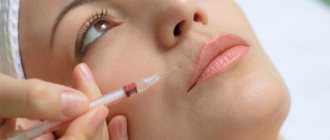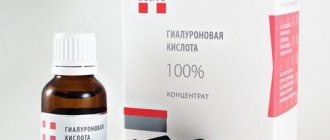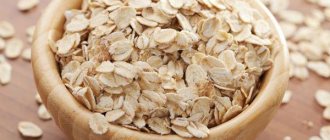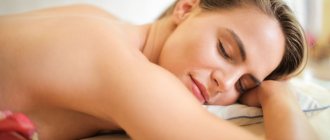Hyaluronic acid is as important a component of our body as blood or water.
It maintains water balance in the tissues and skin of our body and stimulates the production of collagen, which makes the skin firmer and more elastic. But over time, the amount of hyaluronic acid begins to gradually decrease. And as a result of exposure to an aggressive external environment, improperly organized nutrition, and bad habits, the skin tone decreases, its firmness and elasticity are lost, the oval of the face becomes blurred, and dryness and wrinkles appear.
What can hyaluronic acid do?
This substance is found throughout the human body, but the highest concentration is achieved in the skin. Thanks to it, cells maintain the correct water balance, maintaining tone and maintaining elasticity. After all, one molecule of acid binds and holds up to 500 molecules of water.
A young body actively produces this substance, so until a certain age we do not encounter problems with wrinkles. As soon as the moisture begins to leave faster, but does not have time to accumulate again, the skin dries out, becomes flabby and uneven.
Innovations come to the rescue to help restore natural moisture. But everything new and modern does not have to be expensive. Hyaluronic acid purchased at the nearest pharmacy and used at home can create a real sensation in the “Before” and “After” assessment. Do you want to stun a cosmetologist with the resulting effect? Then let's take a step-by-step look at the issue of proper use of this substance.
Can hyaluronic acid cause acne?
The answer to this question is quite simple - the substance is not capable of triggering the formation of acne, but in some people pathogenic elements still form after the administration of the drugs. However, this should not be blamed on hyaluronic acid or on the specialist who performed the injection procedure and did not test for possible sensitivity.
A test is not required in this case, since hyaluronic acid cannot cause an allergic reaction. The actions of a cosmetologist cannot become a provoking factor, of course, if he has the necessary qualifications and experience. The most common cause of acne after the introduction of hyaluronic acid into the skin is neglect of skincare procedures.
When performing injections, small injuries remain at the skin puncture sites that require proper care. If this is neglected, pathogenic microorganisms can penetrate into the wounds, which cause rashes of various types.
Therefore, in order to avoid any complications after the procedure for introducing hyaluronic acid, you should not neglect skin disinfection and proper facial care. After the procedure, for 2 days it is recommended to wipe the skin in areas treated with a disinfectant solution, for example, Chlorhexidine, 2–3 times a day. This will help prevent inflammation and rashes. We should also not forget about carrying out the usual procedures for cleansing the skin, moisturizing and nourishing it.
How to use at home
The acid can be purchased in liquid form in small ampoules or in the form of a dry powder. It is independently added to any skin care cosmetics, as well as to sunscreens. The dosage should not be exceeded to avoid oversaturation and a possible allergic reaction. To enrich cosmetics, 0.1–1% of the substance from the total volume of the product is sufficient, and the percentage of input depends on the general condition of the skin. Below are a few specific mixing ratios for commonly used cosmetics:
- 0.05 - 0.3% is added to cleansing cosmetics;
- In moisturizing milk or oil – 0.05 – 0.5%;
- In cosmetics with a high content of moisturizing components for dry skin – 0.1 – 1%;
- In tanning products and after – 0.05 – 0.5%.
It is best to prepare such a mixture little by little so as not to spoil, and store it in the refrigerator in an airtight container for no more than 2 weeks.
Products enriched with hyaluron work more effectively in combination with mesotherapy. To experience the full power of this device, you don’t have to visit a cosmetologist; you can simply purchase the device and use it. The mesoscooter is a roller with the finest steel needles, and due to micro-punctures, beneficial substances penetrate into deeper layers. By applying the mixture to the skin and using a mesoscooter, absorption increases to 86%. Therefore, the importance of such a device is worth thinking about, especially if you have deep wrinkles.
How do you know what grades of acne there are?
Many people in the modern world face such a problem as acne. This is a common skin disease that can occur for various reasons: metabolic disorders in the body, hormonal imbalances, excessive activity of the sebaceous glands, unfavorable environmental conditions.
acne disease
Important: Acne has several degrees of severity, so it is important to know how the disease is treated in different forms. The more serious and severe the acne disease, the more difficult it is to eliminate it and the more the body suffers.
Professionals divide this disease into four degrees:
- weak form
- medium shape
- severe form
- very severe form
The degree can be determined based on the external signs of the disease, the number of rashes, their location, peeling of the skin and redness. Doctors recommend monitoring the dynamics of the spread of the disease, so if the rash does not decrease, but rather increases, treatment is necessary.
comedones
Depending on the severity of acne, several types of acne can be distinguished:
- comedones - so-called “black spots”, which can often be observed on problem areas: nose, forehead, chin
- papules are pimples of a reddish or bluish hue, they do not cause any pain on the face and their size does not exceed five millimeters
- pustules are pimples similar to papules, but with an abscess. The pimple may fill with white or yellowish pus. Acne often causes pain and redness around it.
- Nodules are the worst type of acne. Their size exceeds five millimeters and can cause pain. They have a fairly dense consistency, and the color turns pink, red, bluish and even purple. It is not uncommon for such nodes to leave scars on the skin.
Mild acne
Generally, anyone can have red pimples on their face. The reason for this is not acne at all. A pimple is an inflammation of the skin caused by bacteria or a reaction to a normal hormonal imbalance.
A mild degree can only be diagnosed if you regularly notice about ten pimples or comedones on your face.
mild acne
It is comedones that provoke the appearance of papules. The pore from which the hair follicle grows becomes clogged with sebum, sweat, dust and dirt from the environment.
The top of the comedone is covered with a crust (that same black dot). Dirt provokes inflammation of the skin tissue and the appearance of pimples. Mild acne does not tend to develop into pustules and nodules.
Moderate acne
The average degree of acne can be diagnosed if there are regularly from ten to thirty comedones and papules filled with pus on the face. As a rule, those suffering from moderate severity experience discomfort and complexes in relation to their appearance.
Homemade face masks
The use of hyaluronic acid will not only rejuvenate, but also give an even tone to the face, cure acne and rashes, and also remove old post-acne scars (consequences of acne). The visible effect of this procedure is already noticeable after the second or third use, and the recipes are simple and quite accessible.
- Dedicated to normal skin type - mix 40 g of natural yogurt or kefir with 5 drops of liquid hyaluron. Apply the mask to a damp surface with a brush, let it dry and after 15 minutes rinse with water.
- Nourishing mask recommended for normal and dry skin types – Take a ripe banana, puree it and add the yolk. Then add 5 drops of acid, 15 drops of retinol and achieve uniformity. Apply the mixture in a thick layer to cleansed and exfoliated skin for 40 minutes; this time should be spent lying down, and for a better fit of the mask, place a towel on top. Remove the remains with a napkin.
- For dry, fresh cucumber must be peeled and blended into a homogeneous mass. Add 10 g of yellow clay, 12 drops of acid to the puree and mix the ingredients well. After cleansing and steaming the skin, apply the mixture for 30 minutes and rinse with warm water.
- For dehydrated people with vitamin deficiencies - mix 15 g of applesauce with 5 g of finely chopped orange zest, add 15 drops of liquid hyaluron, 3 ml of glycerin and mix. Apply the mixture and leave for 40 minutes, then rinse with water and moisturize the skin with olive oil.
- What to do if you have combination skin with oily, enlarged pores? Make a simple mask with honey. Take 10 drops of hyaluron, 12 g of honey, 15 g of natural yogurt without additives, 15 g of chickpea flour, mix and dilute with clean water to a comfortable consistency. We apply a mask to a cleansed face, it is more convenient to do this with a brush, leave for 30 minutes and wash.
- A lifting mask for those over 35 requires an intensive course of 15 applications. You need to dilute a 22 g gelatin bag with warm green tea until completely dissolved, add 5 drops of vitamin A and 10 drops of hyaluron. Before applying the mask, it is advisable to steam your face with a hot towel or over a herbal water bath, remove excess liquid and begin to distribute the mask. Using a brush, layer the prepared mixture until it is finished and leave for 30 minutes. We remove the frozen gelatin film and apply anti-aging care enriched with hyaluron on top.
We have talked about the application, now it is worth explaining the limitations on the frequency of use. The average anti-aging course is 7-10 procedures, for deep wrinkles it increases to 15 sessions. This can be the use of acid as a serum under the main cream or as part of active masks. Such courses are carried out 3-5 times a year so that the skin does not get used to it and does not lose its independent ability to regenerate.
What are the benefits of a face mask with hyaluronic acid ^
- KWC extra moisturizing mask with hyaluronic acid will not only moisturize the skin, but also help even out skin texture and complexion, and also fight the appearance of wrinkles. This mask was developed by Japanese specialists as an effective means of express care for aging skin, so the result will be noticeable immediately after its use.
- Alginate mask with hyaluronic acid and marine collagen from AlgoNatural is widely used in beauty salons. Its unique formula is suitable for any skin type and any age.
- Moisturizing cream mask with hyaluronic acid and sea extracts based on thermal water from Kopa. It also contains kelp, soybean oil, fucus, vitamin E, kaolin and urea. This mask helps improve immunity, remove toxins, smooth out wrinkles and stimulate the regeneration process of skin cells.
- The Dizao Express mask with hyaluronic acid is not only an express care product, but also a budget option. This mask is sold individually and a course of 5 masks every 2 weeks is recommended.
- Modeling two-phase collagen lifting mask with hyaluronic acid and rosemary from Beauty Style is suitable even for sensitive skin. This mask effectively softens, moisturizes, models and tones your skin. The skin becomes firm and elastic, and fine wrinkles disappear.
Masks with hyaluronic acid can also be made in beauty salons; we can say that they are recommended to be made there. Cosmetologists will not only tell you about all the beneficial properties of hyaluronic acid, but will also clearly demonstrate the effect of using masks with it on your skin.
The human body contains approximately 10-15 grams of hyaluronic acid, and when it ceases to be produced, active aging processes begin and many cosmetic defects appear: sagging, dryness, peeling, i.e. all characteristic signs of age-related changes.
Thanks to hyaluronic acid for the face, available in the form of ampoules or powder, you can slow down negative processes and prolong the youth of the skin. The secret is that hyaluronic acid retains natural moisture, maintains optimal water balance in the dermis, accelerates cell regeneration, fills all unevenness and increases elasticity.
In what cases is it recommended to use masks with hyaluronic acid:
- Wrinkles, sagging,
- Drooping oval and poor complexion,
- Pigmentation,
- Acne and pimples,
- Peeling and dryness.
The benefit of masks with hyaluronic acid lies precisely in preserving youth and maintaining the moisture level necessary for the skin, because without it, the dermis begins to age faster, and wrinkles appear more clearly.
How does hyaluronic acid act on facial skin:
- Forms a protective layer on the upper layer of the epidermis that prevents exposure to external irritants,
- Softens and moisturizes dry flaky skin,
- Maintains optimal moisture levels
- Smoothes out wrinkles
- Increases elasticity and firmness,
- Removes harmful substances and bacteria, relieves inflammation, eliminates acne and blackheads.
Hyaluronic acid is best suited for dry dermis, but its use for oily skin would be quite appropriate, because it optimizes the functioning of the sebaceous glands in such a way as to bring the condition of any epidermis back to normal.
- Poor blood clotting
- Pregnancy and breastfeeding period,
- Infectious skin diseases,
- Severe inflammation
- Cuperosis,
- Condition after peeling or grinding.
Rules for using hyaluronic face masks at home:
- In addition to purchasing it at the pharmacy, you can extract the acid yourself from eggshells or cockscombs,
- Procedures should not be carried out in hot weather and more than twice a week,
- Before each session, you must remove all makeup from your face, and at the end, remove the mask with warm water.
The results of using a hyaluronic face mask at home can be compared with the effect of expensive procedures in the salon:
- Even the deepest wrinkles are smoothed out,
- Pigment spots disappear
- Increases elasticity and firmness,
- The functioning of the sebaceous glands is normalized,
- The sagging contour of the face is tightened.
“A mask with hyaluronic acid and cottage cheese helped me a lot: the dark spots became discolored after literally 5-6 procedures, but I’m not talking about perfectly smooth skin at all. The effect was very impressive!”
“The first time I made a mask was when it was stuffy and raining. As a result, due to the increased humidity, the composition almost instantly turned into a thick mixture that was difficult to apply. Apparently, it was not worth using hyaluronic acid under such conditions. The next time the air was dry, everything went perfectly, and now I’m finally rejuvenated!”
“I absolutely loved the mask with yolk! I did it all the time in winter, because... chapping often occurred. In addition, it rejuvenates well, as I was convinced of in 5-7 sessions.”
In-house laboratory
In this section we will answer the question of how to make hyaluronic acid at home. If for some reason the ready-made pharmacy does not suit you, then you can get it from some products in your own kitchen.
- It is located directly in the tissues of the animal body, from where we will extract it. Fresh cockscombs are perfect for this purpose; it will be enough to take 5 pieces, rinse thoroughly, place in a pan with purified water and cook for about 20 minutes. After straining the resulting broth, put the scallops back on the fire for 1 hour. The remaining liquid after cooking will contain natural and freshly obtained hyaluronic acid.
- Eggshells, which we throw into the trash every day, are also rich in hyaluron. It must be washed thoroughly, the film removed, dried and turned into powder. Then add the crushed shells to boiling clean water and simmer over low heat for a long 12 hours, adding water as needed. All that remains is to strain the resulting broth and it is ready for use.
Prepared culinaryly, it can be immediately applied to the skin without adding any additional ingredients. This is what attracts many women when choosing between a pharmacy ampoule and home cooking. We advise you to try both options and choose the most suitable one for yourself.
Hyaluronic acid for the face: modern technologies
Hyaluronic acid is the basis of many cosmetic products that are used to combat wrinkles. Serums, creams and masks based on it enhance collagen synthesis, revitalize and cleanse the skin, smooth out wrinkles and facial folds, and tighten the skin.
But most of these products have great difficulty penetrating the distant layers of the skin. Therefore, their effectiveness is not always effective.
Until now, hyaluronic acid is delivered to distant layers of the dermis using intradermal injections, which is called hyaluronic facial mesatherapy.
KK Adapt. 5 paragraph
But mesatherapy must be carried out regularly and constantly, swelling and bruising may remain on the skin, you cannot sunbathe or swim in open waters, the course of facial mesatherapy lasts 5 months, the cost of these procedures is high, from 5,000 rubles.
This year, Israeli effective anti-wrinkle face masks with hyaluronic acid appeared. These masks are completely safe, have tightening and rejuvenating effects on the skin, and are easy to use at home.
Such masks seem to “pull out” wrinkles from the depths, due to the nanosilica matrix, and smooth them out, improving cell nutrition by increasing blood circulation.
The hyaluronic acid of such masks maintains the full concentration of intercellular fluid for a long time. As a result, we have facial skin lifting and rejuvenation without injections.
The use of this type of mask delays the evaporation of moisture from the dermis of the face and also replenishes lost fluid.
The drug used for masks is called Neoleor, and it can compete in its effectiveness with a course of mesotherapy, only without injections.
Hyaluronic acid almost does not cause allergies when used. But since it is obtained from the bones, cartilage and joints of birds and animals, if you are allergic to eggs, animal meat or poultry, a positive reaction to products with this acid is possible.
Currently, hyaluronic acid is produced with high and low molecular weight. In cosmetology, preference is given to an acid with a low molecular weight, since it reaches more distant layers of the dermis and retains as much moisture as a molecule with a large molecular weight.
Cream mask for dry skin with glycerin and honey plus yolk: proportions, recipe, use
This product requires the following ingredients:
- 1 potato, boiled in milk;
- 1 tsp. glycerin;
- 1 yolk;
- 1 tbsp. spoon of olive oil;
- 2 tbsp. l. water;
- 1 tsp. honey
In this case, mashed potatoes are first whipped, to which all the ingredients are added, except honey. After adding it, the mixture is mixed until smooth, applied to the face for 15-20 minutes, and then washed off with water at room temperature.
Mask of honey, glycerin and gelatin for oily skin: ratio, recipe, how to apply
This recipe is suitable even for those with oily skin who question the acceptability of using glycerin. After all, its combination with gelatin refutes this opinion.
To prepare a mask to moisturize oily skin you will need:
- glycerin, honey (15 ml each);
- gelatin (5 g);
- aspirin (1 tablet);
- water (100 ml).
Cooking algorithm:
- Grinding aspirin.
- Soak the gelatin for 20 minutes (to “swell”).
- Mixing all components (in a glass/ceramic container).
- Heat the resulting mixture in a water bath with constant stirring until all components are completely dissolved and cool it.
- Apply this mask to the face for 20-25 minutes, then rinse the skin with water at room temperature.
This product can be prepared for future use by storing it on the bottom shelf of the refrigerator for up to 30 days.
Warm it up a little before each use. Applying this mask daily helps get rid of comedones and acne (pimples).











